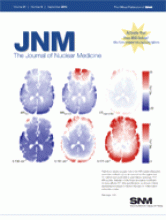REPLY: We thank Drs. Gollub and Akhurst for their interest in our article (1) and acknowledge their work in this field.
We agree with their comment about the large volumes of CO2 insufflated. In the article, we report the volume of carbon dioxide insufflated in the supine position (3.1 L; range, 2.2–4.1 L) before the supine CT acquisition and then the additional mean volume of gas insufflated just before the prone scan acquisition (based on assessment of the prone scout scan). We reported the volume in this manner to give readers a practical guide as to how we performed the technique—the total volume of gas insufflated over the whole hour is of less relevance. As to this total volume of carbon dioxide, we agree this volume can be very large because of absorption of the gas during the procedure. By reducing the pressure to 15 mm Hg, we obtained total volumes that were a little smaller than those experienced by Dr. Gollub but were in the range of 10–40 L.
The increase in specificity afforded by PET in our study does rely on the assumption that significant pathology would be PET-avid, which we agree is not always the case. Reporting of colonic neoplasia during CT colonography is rarely a yes/no phenomenon. Readers take many factors into consideration when deciding whether to call a lesion real or not: for example, morphology, lesion movement, attenuation homogeneity, general state of bowel preparation, and distension. 18F-FDG avidity or otherwise of the lesion is an additional factor that may aid the radiologist, and in our feasibility study we found that false-positives were reduced. It is perhaps more intuitive that PET would increase sensitivity in nonlaxative studies. We did not find this to be so, but as we discuss, we used an experienced reader to report the CT colonography component of the examination. It would seem likely that 18F-FDG avidity would improve the sensitivity of less experienced CT colonography readers, somewhat akin to computer-aided-detection software, and further work on this possibility is under way.
A difference in sedation techniques may in part explain some of the patient discomfort during colonoscopy that we reported. Of course, heavy-sedation regimes are not without risk, particularly in older patients. In a recent study investigating the use of propofol and remifentanil during colonoscopy, oxygen saturation dropped to less than 90% in 5 of 25 patients, who required bag mask ventilation (2). Our endoscopists carefully titrated the amount of administered analgesia and sedation against patients’ feeling of discomfort during colonoscopy to maximize both patient comfort and safety.
It is reassuring that patients generally tolerated both colonoscopy and PET/CT colonography reasonably well, and although we can only speculate on the views of questionnaire nonresponders, it would perhaps seem unlikely they were “disgusted”! It is absolutely correct that when assigning an overall preference between 2 tests, patients weigh many factors, not just the physical experience of the test itself. We believed that the convenience of bowel preparation for PET/CT colonography was a major factor, but there are many other facets more difficult to quantify, such as test environment, staff attitudes, posttest care, feedback of results, patients’ assumptions on test performance, and fear of complications. We know, for example, that patients often assume that new, expensive imaging technologies must be “better” than conventional tests (3). Although quantitative questionnaires do have the benefit of speed and simplicity, in reality detailed qualitative studies are required to tease out which factors most influence patients’ test preferences, and even then, these factors often differ widely between individuals.
To justify the use of nonlaxative PET/CT colonography as a first-line test in the investigation of older patients, a high positive predictive value is essential, as Drs. Gollub and Akhurst correctly state, because patients with reported pathology must undergo invasive colonoscopy with bowel preparation. However, the test must also be sensitive (low false-negative rate) and so have a high negative predictive value. Our study also showed this to be so for PET/CT colonography—indeed, by combining the attributes of CT colonography and PET, PET/CT colonography would seem to be a highly reliable test for classifying higher-risk symptomatic patients into those with or without significant colorectal neoplasia.
- © 2010 by Society of Nuclear Medicine







